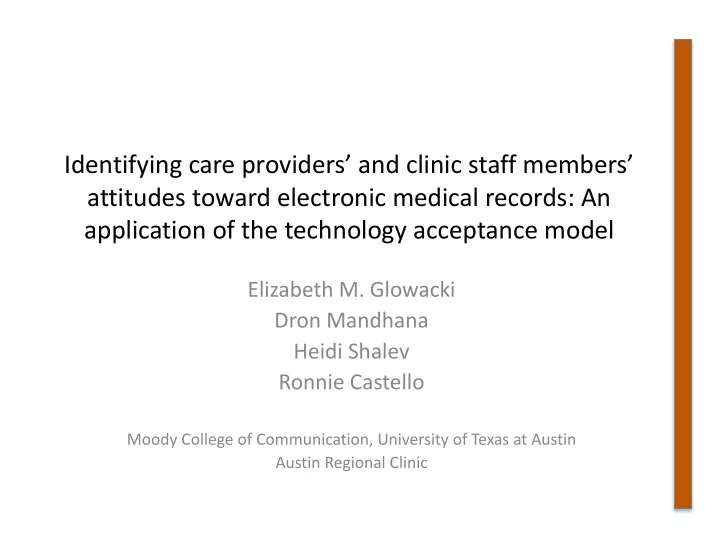

Identifying care providers’ and clinic staff members’ attitudes toward electronic medical records: An application of the technology acceptance model Elizabeth M. Glowacki Dron Mandhana Heidi Shalev Ronnie Castello Moody College of Communication, University of Texas at Austin Austin Regional Clinic
Electronic Medical Records (EMRs) Presence in Healthcare -78% physician offices -84% emergency departments Facilitators to Use -Trained personnel - Patient engagement Workload? Age? Barriers to Use -Security concerns -Lack of standardization
Electronic Medical Records (EMRs) Patient Portals - Access personal and family health information - Password-protected, customizable - Lab results, appointments, medications - Messaging
Technology Acceptance Model Adoption of new technologies in organizations • Perceived usefulness and ease of use • Relevance to job • Subjective norms – others’ attitudes • Patients and providers engage with or reject health • technologies
Objectives Apply Technology Acceptance Model to assess EMR: 1.) Adoption within local clinic 2.) Impact on workload 3.) Utilization among multiple roles
Objectives RQ1: How do primary care physicians, nurses, and clinic staff describe their attitudes toward the clinic’s EMR system? RQ2: How do primary care physicians, nurses, and clinic staff describe patient engagement with the clinic’s EMR system? RQ2: How do primary care physicians, nurses, and clinic staff describe the effect of the clinic’s EMR system on workload?
Method Semi-structured, audio-recorded interviews (N=39) • 11 primary care physicians (family, internal, or extensivist medicine) • 9 nurses (registered nurses, licensed practical nurses, triage nurses) • 6 administrative or management positions • 5 medical assistants • 5 patient care coordinators • 3 referral coordinators
Method Worked with administrative team to develop interview topics: – Reasons for engaging with portal – Patients’ perceptions and adoption of portal – Portal as a communication tool – Opportunities for improvement – Benefits of using the portal – Training opportunities – Workflow
Results Themes: 1.) Appropriate use and educating patients about meaningful engagement 2.) Active versus inactive users 3.) Mixed reactions to age as a barrier 4.) Increases and decreases in workload 5.) Need for a message filtering process
Conclusions Most salient concern from nurses and staff had to do with appropriate use • of the messaging and appointment-scheduling features – Frustration with patients who abuse the messaging feature Patients tried to schedule appointments through the EMR in emergency situations or did – not allow for enough time Importance of educating patients about meaningful engagement • Nurses described walking their patients through the activation process if they had time – – Ask patients about whether or not they like to use technology and email, which can be helpful for deciding if a patient will actually benefit from the EMR Age more of a factor for doctors, but less relevant when identifying • barriers to use among patients Comfort with and attitudes toward new technology was a better predictor than age –
Conclusions • Identifying “active” versus “inactive” users Problems with patients who initially activated their EMRs, but never returned to – it (unaware of lab results and messages from doctors) • Impact on workload – Both Increased and decreased- respond to more messages, but spent less time on the phone with a patient or calling a pharmacy for refills • Emphasis on staff and specialization of roles – Process of responding to patients’ messages had been improved by the clinic’s recent effort to implement a message filtering process – Staff screened and streamlined messages- only those having to do with the patient’s medical condition reached the doctor’s team
Technology Acceptance Model Subjective Norms/ Relevance to Job Perceived Usefulness Ease of Use Others’ Attitudes -Message Filtering -Trained Staff -Use among Team (Doctor/Nurse/Med. Assistant) -Encouraged Use -Meaningful Use -Highly Relevant (user status, log-in info.) -Appropriate Use (scheduling, messaging) Adoption and Engagement
Thank You Elizabeth Glowacki glowacki@utexas.edu
Recommend
More recommend